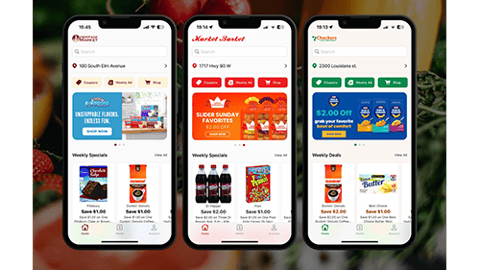EXCLUSIVE: The Future of Retail Media
Retail media has seen a massive shift in recent years from being a buzzword to a must-have for every food retailer in the industry. With expected market growth of 12% annually to an estimated share of about $140 billion in 2026, according to Bain & Co., retail media will pick up share from other digital advertising channels and likely surpass television as a go-to form of advertising in the process.
A necessary evolution is happening in retail media as it picks up steam, with issues such as customer data, artificial intelligence (AI), interconnectivity, governance and transparency being more widely discussed and more closely scrutinized. Moreover, experts believe this evolution will help level the playing field for small- to midsized grocers competing with retail giants like Walmart and Amazon, and potentially bring new efficiencies to the discipline.
[RELATED: Walmart Unlocks New Retail Media Efficiencies]
“The future of retail media is evolving into a more inclusive and interconnected landscape,” says Sean Turner, co-founder and chief innovation officer of Seattle-based software company Swiftly. “This evolution encompasses not only large retail chains, but also sees independent and regional retailers banding together into broader networks.”
With more grocery players than ever entering into the retail media game, opportunities to grab advertising market share and increase revenue will no doubt abound, but what should those retailers be paying attention to when considering the future of retail media?
The In-Store Opportunity
While retail media has primarily existed online up to this point, many industry experts believe it will increasingly move into brick-and-mortar stores. Nick Larkins, co-founder and chief product officer at Irvine, Calif.-based in-store media company Qsic, asserts that the rapid growth of retail media has proved that proximity to the point of purchase is a key factor, especially considering that a large majority of purchases still happen at physical retail.
“That’s why it feels like the entire industry is laser-focused on innovating and advancing the tech related to in-store touchpoints right now,” explains Larkins. “People on all sides of the business know it’s becoming paramount to engage consumers at this critical point in the path to purchase, whether that’s through video, audio or a mix of channels. Even non-endemic brands are seeing this value.”
According to Turner, deploying technologies such as interactive screens and personalized mobile notifications is allowing retailers to transform shopping into a more personal and engaging experience. “This tailored approach makes each visit feel special and unique, enhancing the appeal of the in-store experience,” he observes. “It also maximizes the use of physical locations, providing a compelling alternative to the impersonal nature of online shopping.”
Why AI Will Be a Game Changer
According to Artem Lavrinovich, chief data and product officer at Chicago-based Cooler Screens, the future of retail media lies in the strategic integration of innovative technology and data analytics, particularly through the application of AI. He expects customization and relevance in shopper experiences to grow, thanks to AI’s ability to analyze and leverage in-store shopping behavior.
[RELATED: What Leading Grocers Are Saying – and Advising – About AI]
“This integration will continue to develop, enabling more dynamic and context-sensitive advertising that resonates more effectively with consumers,” says Lavrinovich.
While noting that AI and machine learning are not one-size-fits-all solutions, and often depend on the quality of their data, Nikhil Raj, chief business officer for retail media at Redwood City, Calif.-based commerce platform Moloco, asserts that both technologies can give companies the tools to understand consumer behavior and predict what they might do next in real time.
“By delivering the best experience to brand-new consumers, AI gives all companies who can use it the right way a competitive advantage,” he explains. “It can also help formulate creative assets to be highly personalized to the consumer and optimize campaigns, even midflight, to drive incremental sales.”
A Deeper Focus on Governance, Consumer Protection
An important consideration for the future of retail media is the responsibility of retailers to implement clear policies and practices that prioritize data protection, privacy and ethical use. Larkins believes that the industry as a whole is evolving to stay compliant, with closed-loop reporting revolutionizing the retail media space by introducing a data-driven approach that seamlessly integrates the entire advertising cycle.
“Brands are increasingly demanding accountability for their advertising spend, and retailers must be prepared to respond,” adds Larkins. “This shift is driving the development of new tools that improve measurement and combat ad fraud.”
Additionally, Lavrinovich notes that retailers must develop robust governance frameworks that clearly define the responsibilities and ethical boundaries in the use of both data and AI.
Moving forward on the consumer front, Larkins recommends that retailers use penetration testing to help uncover vulnerabilities that could potentially compromise customer data, since the onus falls on them to proactively safeguard consumer privacy. He also stresses the importance of vetting technology partners to make sure that they’re operating within compliance.
Turner, meanwhile, recommends maintaining policies that customers can easily understand and access, as well as maintaining an open dialog with those customers to help demystify data practices and show them that their privacy is a top priority.
“Reflecting on whether retailers are doing enough, there’s often room for improvement,” says Turner. “Many could improve their approach by simply showing customers the benefits of data usage. When consumers see that their data is used to tailor recommendations, such as personalized offers based on their previous purchases, they are likely to appreciate the personalized touch.”
He concludes: “This straightforward use of data not only meets legal standards, but also naturally builds trust and loyalty by demonstrating direct value to the consumers. Essentially, as long as the benefits are clear and the personalization is evident, customers will be satisfied with the data practices.”
The top retailers (including Walmart) and solution providers in grocery will be talking about innovations like retail media and much more at Progressive Grocer's annual GroceryTech event in Dallas on June 5-7. Click here for more information and to register now.












